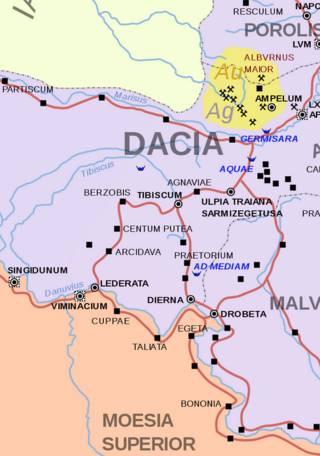
Feldioara is a commune in Brașov County, Transylvania, Romania, about 15 km (9.3 mi) north of the city of Brașov. It is composed of three villages: Colonia Reconstrucția (Bohntelep), Feldioara, and Rotbav.

Angustia was a fort in the Roman province of Dacia in the 2nd and 3rd centuries AD today near the town of Breţcu, Romania.

Castra Arcidava was a fort in the Roman province of Dacia in the area of the town of Arcidava in the 2nd and 3rd centuries AD.

Arcobara was a fort in the Roman province of Dacia in the 2nd and 3rd centuries AD. It was unearthed in the village Ilişua in 1978. The fort was garrisoned by Ala I Tungrorum Frontoniana. On the site 27 stone ballista projectiles were discovered of diameters between 7 and 13.5 cm and weighing up to 2 kg indicating the presence of ballistarii.

Bersobis was an ancient Dacian fortress conquered in Trajan's Dacian Wars with the Romans. It became a legionary fortress in the Roman province of Dacia in the 2nd century AD. It is located near the town of Berzovia, Romania.

Caput Stenarum was a fort in the Roman province of Dacia in the 2nd century AD. It is located 700 m east of the village Boița in Romania at the northern exit of the Olt gorge.
The castra of Brâncovenești was a fort in the Roman province of Dacia in the 2nd and 3rd centuries AD. Its ruins are located in Brâncovenești, Romania.

The Castra of Călugăreni was a fort in the Roman province of Dacia located on the north-western periphery of the modern village of Călugăreni, Romania. The fort was built in the 2nd century AD and abandoned in the 3rd century. Archaeological research also proved the existence of a nearby canabae.
The castra of Poiana was a fort in the Roman province of Dacia near the present town of Poiana. It was built in the 2nd century AD and abandoned in the next century. It was a part of the Limes Transalutanus frontier system and situated at the southern end next to the Danube.
The castra of Gherla was a fort in the Roman province of Dacia. An inscription unearthed at the site proves that the stone fortress was erected in 143 AD. In addition to the vicus at the fort, a nearby contemporary settlement and a Roman cemetery were also unearthed in Gherla (Romania). All these sites were abandoned in the 3rd century.

The castra of Hoghiz was a fort in the Roman province of Dacia. The fort was built in the 2nd century AD, on the left bank of the Olt River, at a place where a Dacian settlement existing already in the 2nd century BC was unearthed. The fort and the nearby village were abandoned in the 3rd century AD. The ruins of the castra are located in Hoghiz, Romania.

The castra of Olteni was a fort in the Roman province of Dacia. It was built in the 2nd century AD. The archaeological site yielded coins issued by the Roman emperors Titus Flavius Vespasianus, Domitian, Trajan, Antoninus Pius, Elagabal and Alexander Severus. The fort was abandoned in the 3rd century. It ruins are located in Olteni in commune Bodoc in Romania.

The castra of Orheiu Bistriței was a fort in the Roman province of Dacia. It was built in the 2nd century AD. Archaeological research also identified the nearby vicus. The castra and the nearby settlement were both abandoned in the 3rd century AD. The ruins of the fort are located in Orheiu Bistriței.
The castra of Bucium was a fort in the Roman province of Dacia in the 2nd and 3rd centuries AD. Its ruins are located in Bucium.

The castra of Cincșor was a fort in the Roman province of Dacia in the 2nd and 3rd centuries AD and part of the frontier system of the Limes Alutanus.

Apulum was a legionary fortress in the Roman province of Dacia from the 2nd to 4th centuries AD, located in today's Alba Iulia, Romania.
The castra of Livezile was a castra in the Roman province of Dacia, located in the north side of the modern commune of Livezile in the historical region of Transylvania, Romania. The fort was erected and surrounded by a ditch in the 2nd century AD. The castra was abandoned in the 3rd century and its ruins are still visible.
The castra of Odorheiu Secuiesc was a fort built in the 1st century AD. A nearby contemporary settlement was also archeologically identified. The castra and the settlement were abandoned in the 3rd century. Their ruins are located in Odorheiu Secuiesc in Romania. At the same settlement, the ruins of a Roman tower can also be identified at Piatra Coţofană.

The castra of Bumbești-Jiu now known as Gară was a fort in the Roman province of Dacia located in Bumbești-Jiu (Romania). It replaced the nearby earlier fort of Castra of Bumbești-Jiu - Vârtop in the 2nd century AD. It defended and secured the entrance to the Jiului gorge and the Roman road from Bumbești through Porceni over the mountains, through the Vâlcan Pass to Sarmisegetuza.

The castra of Bumbești-Jiu now known as Vârtop was a fort in the Roman province of Dacia. It is located 35 m west of the Târgu Jiu - Petroșani road, in Bumbești-Jiu (Romania). It defended and secured the entrance to the Jiului gorge and the Roman road from Bumbești through Porceni over the mountains, through the Vâlcan Pass to Sarmisegetuza.
This page is based on this
Wikipedia article Text is available under the
CC BY-SA 4.0 license; additional terms may apply.
Images, videos and audio are available under their respective licenses.












